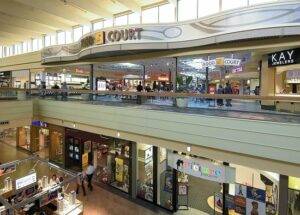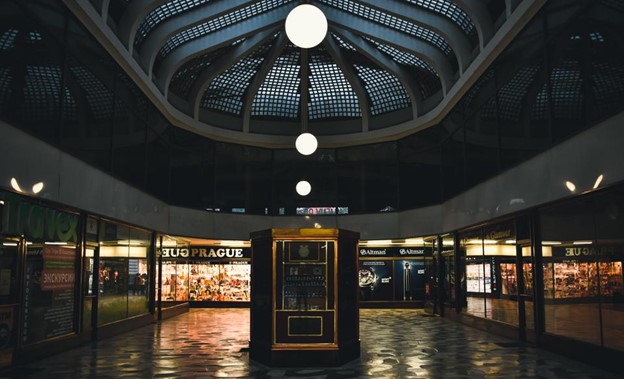Ideas from Around the Country
BE PART OF THE CONVERSATION
Mall Redevelopment Strategies: Keeping Today’s Malls Competitive North America
Sam Black
The Ratkovich Company’s redevelopment of downtown LA’s Macy’s Plaza and the MCI Center office tower.
Source: The Ratkovich Company
MALL OWNERS, faced with shifting consumer preferences or newer competition, regularly confront the need to remodel and redevelop — or lose shopping traffic, retail sales and, eventually, tenants. Successful redevelopment covers a spectrum from spruce-ups and new stores to starting over at the same site with new buildings, streetscapes and diverse uses, new links to surrounding neighborhoods and new approaches to transportation.
Redeveloping a mall to include good connections to bus rapid transit (BRT) or rail is risky if the transit is only “planned,” since some communities have reversed transit construction decisions, taken decades to complete a new transit system, or failed to deliver a good product. If the transit is already there, it should be easier. But even when a transit line is up and running, some developments fail to make the most of their transit connections, leaving shoppers and visitors to hike without wayfinding signs through long, lifeless tunnels, upstairs and then down, or out in the broiling sun, the rain or snow.
Redeveloping a mall with structured parking or new uses like entertainment, a hotel, restaurants or office buildings can be a challenging undertaking. But increasing density and adding a full mix of uses that includes residences, as well as a street grid that connects with existing streets and transit, is even more challenging. This article highlights three of these complex mall redevelopment projects: sites that are being redeveloped with a mix of uses, links to surrounding neighborhoods, and transit connections.
Oakridge Centre, Vancouver
Ivanhoé Cambridge, the owner of Oakridge Centre, one of Vancouver, British Columbia’s most successful malls, is planning to redevelop the center into a true mixed-use complex. Oakridge now has over 150 stores, occupying 575,500 square feet, with an additional 119,300 square feet of space in two six-story buildings, one office and the other mixed office and residential. The enclosed mall, which has a floorplate of about five city blocks, rises one to two stories above grade, with rooftop, structured and surface parking.
The existing mall is adjacent to a subway station on Vancouver’s rail transit system but is surrounded on three sides by its surface parking lots and on the fourth by the two mid-rise buildings. Those structures effectively screen the mall from the view of passengers exiting the subway. Customers coming from the subway to the mall must walk between the two buildings along an uncovered open-air sidewalk.
The new development, planned as a “culturally and environmentally sustainable model that harnesses the potential of a large urban site situated at a transit hub,” as described by Ivanhoé Cambridge, is scheduled for completion in 2023. The rebuilt complex will offer entertainment, grocery, office, residential, restaurant and retail space as well as civic uses. Landscaped open spaces will replace the surface and rooftop parking, and the redesign provides new or improved connections to neighboring sidewalks, streetscapes and the subway. The city has approved the redevelopment plans.
The new Oakridge Centre will offer 424,000 square feet of office space as well as low- and high-rise residential buildings that will contain 2,900 units of affordable, market-rate and seniors housing. The redevelopment will provide a network of walkways and plenty of sidewalk- and street-facing retail, including neighborhood-oriented shops, but no new vehicular streets. It will, however, include a new pedestrian-only street, with civic, community and retail uses along both sides and residential units above.
“One of the goals of the redevelopment is to connect to the surrounding neighborhoods through the pedestrian plan and the architecture, as well as through amenities and retail resources that can benefit the community,” explains Tom Perkins, a design director for Gensler, one of the projects’ architects. The complex will include 14 acres of green and public space, including a nine-acre green roof that will serve as a public park for the community as well as for center employees, residents and shoppers.
All parking will be underground; the plans call for demolishing the small amount of existing structured parking. The amount of parking provided for residents as well as commercial tenants will be less than that typically provided in Vancouver at present. The development, which aims to achieve LEED for Neighborhood Development (LEED-ND) Platinum certification, will incorporate transportation demand management to encourage walking, bike riding, car-sharing and transit use.
The Bloc, Los Angeles
Until about five years ago, retailers in the Los Angeles area did not focus much on shoppers using the city’s new rail transit systems. In recent years, however, according to Cal Hollis, the Los Angeles Country Metropolitan Transit Authority (Metro)’s managing executive officer for real estate, mall owners have realized that suburban residents, who for many decades would not have thought about coming downtown for mall shopping, can now use transit to get to a downtown retail complex as fast as or faster than they could travel to a suburban mall.
“We’ve gone past the tipping point on this,” explains Hollis. In 2013, The Ratkovich Company, a California-based developer and property owner with a portfolio of over 17 million square feet in Los Angeles County, purchased, with partners National Real Estate Advisors, National Real Estate Development and Blue Vista Capital, the MCI Center office tower and the adjacent Macy’s Plaza on South Flower Street in downtown Los Angeles for $241 million. Ratkovich renamed the complex “The Bloc,” started planning and executing a wholesale redevelopment strategy, and decided to make this the first LA shopping center to have a seamless connection to a subway station. The redevelopment, due to be complete by the end of 2015, will deliver 400,000 square feet of retail space, including a new 240,000-square-foot Macy’s, on three floors; a reconstructed, 708,000-square-foot, 32-story office building; a renovated Sheraton hotel; and new restaurant and entertainment tenants.
The one-square-block site will also feature an extensive rooftop “urban square,” outdoor dining and street-facing retail. The location is as downtown and urban as you can get in a modern, car-centric global city. But Los Angeles’ relationship to the automobile is changing, and visitors will also be able to reach The Bloc from the Los Angeles subway’s 7th Street/Metro Center station, the system’s busiest, via a lower-level walkway. The station serves two light rail lines, two heavy rail lines (all four of which are underground at this location), one BRT line at the surface level, and many surface bus routes.
According to Clare De Briere, chief operating officer and EVP, The Ratkovich Company, “The Bloc will be fully accessible via multiple modes of transportation: walking, biking, driving, ride-sharing and public transportation, as well as the first dedicated Metro Line connection point in the city. … We hope that the transportation hub we’re creating at The Bloc will help to further spur the revitalization of Downtown Los Angeles.”
Ratkovich is paying for half the $9.2 million cost of this underground connection, which will indeed be the first between a retail complex and the LA subway system. Negotiations between Ratkovich and Metro for the Bloc-subway link involved a wide range of design, signage, construction, operation, maintenance and liability issues. Subway patrons not using the retail complex will nevertheless be able to exit through it to the street. The fire, safety and security systems of both The Bloc and Metro have to be able to communicate with each other. The subway connector is expected to open at about the same time as the redevelopment.
Westfield Century City, Los Angeles
Westfield Century City mall, on the west side of Los Angeles, sits on Santa Monica Boulevard about a mile east of Interstate 405. The mall comprises 878,200 square feet of retail space on two levels above grade, with 148 stores, restaurants and theaters, about 2,500 parking spaces and a nearby office building. Australian shopping center developer Westfield Group owns and manages the mall.
Westfield is in the process of redeveloping the complex by adding over 400,000 square feet of new retail space, with 50 new stores, new and relocated anchors, a new 15-story residential and office building that will replace the existing office building and about 2,200 new parking spaces. The owner plans to demolish the entire property on a section-by-section basis and then rebuild. Construction is underway, a new parking structure is already complete and Westfield expects to deliver the new mall and residential/office tower by 2017.
The redeveloped Westfield Century City will remain an internally focused facility. Westfield Co-CEO Peter Lowy describes the revamped mall experience as “a new urban escape” from the city and traffic, with an “environment that typifies our Southern California lifestyle.” The redesigned mall will not have a network of streets or a mix of uses within the mall; the residential/office tower will be adjacent to it. The redesign, however, includes large mall spaces open to the sky, with gardens, plazas and tree-lined walkways.
In addition, the mall will feature a direct, enclosed connection to the city’s future Purple Line subway extension. Although the increase in parking indicates that Westfield envisages an even more car-oriented future for the mall, it has also committed to building and paying for the subway connection. Westfield has not yet approved a detailed design of the connection, but the company states that it wants patrons to “experience the mall,” in Hollis’ words, from the moment they enter from the subway. The Purple Line is a deep-tunnel high-speed system; the segment of the line that extends to Westfield has cleared all regulatory reviews and is set to be under construction by 2019 and to open in 2026.
Other Examples
Many additional examples of successful mall redevelopments that incorporate some of the features highlighted here can be found in cities throughout North America. These include the following:
General Growth Properties’ Mizner Park in Boca Raton, Florida, where an enclosed shopping center was transformed into a mixed-use complex with civic spaces, offices, luxury apartments, townhomes and a multistory, street-facing retail component.
PREIT’s The Gallery in downtown Philadelphia, where an existing urban mall is being redeveloped with better subway connections and street-facing retail.
Midway Companies’ CityCentre in Houston, where the Town & Country Mall was transformed into a mixed-use development with new retail space as well as apartments, townhomes, offices, a hotel, green spaces and walkable streetscapes.
Numerous examples in Washington, D.C., and its Maryland and Virginia suburbs, where an extensive transit system serves not only the center city but also suburbs ready for high-rise mixed-use development.
There are also many examples of malls that have been transformed into lifestyle centers through the addition of landscaped pedestrian areas and/or new stores and restaurants set along new streets with limited or no parking and wide sidewalks. Lifestyle malls may also include a mix of uses and transit connections, but even when they do not, they are more pedestrian-oriented than their predecessors and thus are more appealing to today’s shoppers and restaurant-goers than the traditional enclosed mall.
Malls located in dense mixed-use neighborhoods already may be achieving some of the goals of mixed-use design — built-in customers, 18-hour pedestrian presence and so forth — making it unnecessary for the mall itself to add new streets or additional uses. There is no rule that every structure must be mixed use; urban neighborhoods are the original “mixed-use developments.”
Finally, when a mall owner develops for-sale housing on the mall site, the owner becomes a member of a broader community in which it may have influence and a management role, but no longer has total control. Some owners may see this as importing complexity and uncertainty, but David Kitchens, a principal in Cooper Carry’s mixed-use specialty practice group, which had design roles in some of the malls referred to in this article, points out that adding residential uses brings “customers who are living at your retail development, are contributing to a lively pedestrian presence 18 hours a day and, in making this choice of where to live, are proving that they are members of today’s urban-oriented generation. In other words, they are fans.”
Sam Black is a contributing editor to Development Magazine and an attorney and past chairman of the Washington, D.C., Smart Growth Alliance. This article was originally featured in Development Magazine’s Winter 2015/2016 issue.
Chesapeake Alliance






